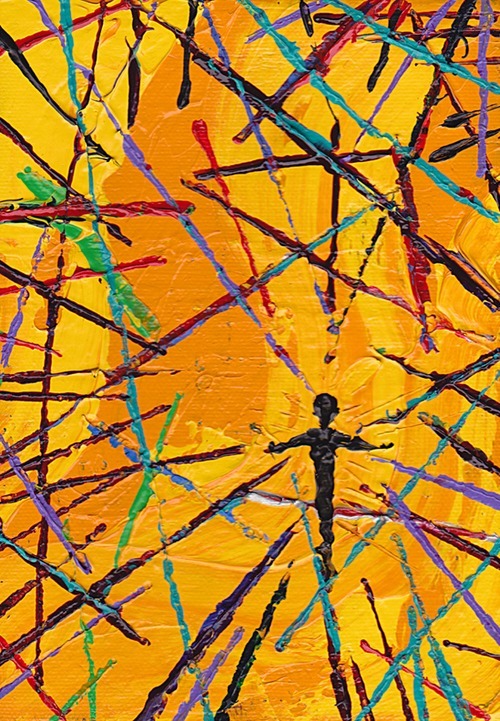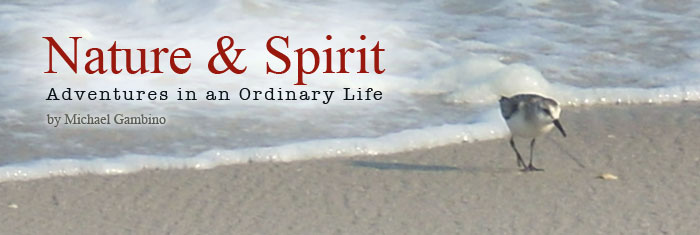The Hero’s Wound
 Saturday, February 4, 2012 at 09:44PM
Saturday, February 4, 2012 at 09:44PM  "Sacrifice" © Michael Gambino, 2005, Acrylic on canvasA constant theme in my life since childhood has been what I have come to know as the hero’s journey. Even before I knew there was such a thing, I felt its power influencing my life. As a child, I would sometimes role-play fictional characters from the 60’s and early 70’s television shows. I was often lost in space, or coping with the unpredictability of time-travel, or risking my life to save a fallen comrade in dramatic scenes from classic war movies. Firemen, policemen, the Apollo astronauts, Batman, and fighter pilots all fed my imagination and helped me explore the nature of valor, if only in my backyard. My G.I. Joe action figure was to me an adventurer, more so than a soldier. Alone in trackless jungles learning to survive giant snake attacks, poison arrows, and quicksand. He got beat up a lot, but kept getting back on his plastic feet.
"Sacrifice" © Michael Gambino, 2005, Acrylic on canvasA constant theme in my life since childhood has been what I have come to know as the hero’s journey. Even before I knew there was such a thing, I felt its power influencing my life. As a child, I would sometimes role-play fictional characters from the 60’s and early 70’s television shows. I was often lost in space, or coping with the unpredictability of time-travel, or risking my life to save a fallen comrade in dramatic scenes from classic war movies. Firemen, policemen, the Apollo astronauts, Batman, and fighter pilots all fed my imagination and helped me explore the nature of valor, if only in my backyard. My G.I. Joe action figure was to me an adventurer, more so than a soldier. Alone in trackless jungles learning to survive giant snake attacks, poison arrows, and quicksand. He got beat up a lot, but kept getting back on his plastic feet.
As a freshman in high school, I was introduced to Tolkien's world of The Lord of the Rings. It offered me a variety of role models at a time when I didn’t have any (but desperately needed) significant flesh-and-blood mentors or guides. The fictional characters guided me with their archetypal energies to have courage even as I suffered emotional and spiritual wounding and awakening. Archetypes and borrowed themes from ancient Scandinavian, Celtic, and European myths and folklore are living reservoirs of the wisdom of the ages. Their power continues to capture my imagination.
Throughout our lives we suffer injuries of all manner and size. Some injuries are physical, others are emotional or spiritual. Most heal quickly – our lessons learned, assimilated, and largely forgotten. Yet some of our wounds carry a hurt that does not pass so readily. They lie deeply embedded within our psyche, rising now and again from the ashes of our past. They speak to us, demand something from us. They are living shadows, fragments of our earlier selves and they carry a message. In the realm of myth and storytelling, some wounds are referred to as a hero’s wound, or a sacred wound. Despite their painful haunting years after the initial event, such wounds are considered a gift (though most of us, if we could, would refuse such a gift in the moment of its delivery). Whether we embrace them as such or not, sacred wounds are powerful forces that shape the path of our lives as we seek to heal them in some way, even as we put much energy into hiding such scars from the world. In other words, while they may feel like our the most fragile part of us, they are often what drives us forward in life.
A volcanic eruption shatters mountains. An earthquake alters the course of a river. This is the potential power of the such wounds – to alter our internal or spiritual landscape. They shake things up in a big way, and the challenge is to pick ourselves up and make our way across the new, unfamiliar landscape. More precisely, we have to try and understand the implications of the wound – the awakening, the newfound awareness and perspective we receive, moving forward to embrace life once more, in spite of any persistent grief. The hero cannot go back to what was, for the landscape has changed. The bridge has crumbled behind him, as it were.
The sacred wound is a gift of potential wisdom that is unwrapped layer by layer over the course of a lifetime. This kind of wound is essentially an opening or expansion of our spiritual consciousness. This wounding – an apparent weakness – can help us find our strength. We all have natural strengths and natural weaknesses. Our task, our choice, is to acknowledge both, improving what we can during our lives. Sacred wounds can ground us in our humanity, point to our spirituality, and keep us open to the immense power of compassion and intimacy in our lives.
With an addiction to competition in nearly every corner of our lives, weaknesses and vulnerabilities are seen as aspects to be crushed aggressively, or at least armored, and at worst, hidden away from even our own self-reflection. Weakness and vulnerability are broadly thought of as negative. While this can be true, it would be a very limited perspective. So, I would like to distinguish vulnerability from weakness. The word weakness connotes that it is the opposite of strength. As I see it, the conscious willingness to be vulnerable is an act of sacrifice. This is what it means to surrender. In this there is power. I believe that this kind of vulnerability is a great strength. Mohandas Gandhi comes to mind as a prime example of strength that lies in conscious vulnerability.
Vulnerability (from the Latin, vulnerare, meaning “to wound”) hints at there being a soft spot, a place where we are susceptible to the world – both its joy and suffering. In our lives we offer and ask for love in its many aspects and in many degrees. In doing so, we willingly face the hurt of rejection and fear for the chance to win love. This always requires courage, especially after being hurt the first time we lay ourselves bare and unguarded to others.
In myths and folktales, a hero’s vulnerability is often revealed by a dragon or some other monster, sorcerer, demon, or witch, or by clever, mischievous characters from the realm of Faerie. In many stories the hero is set upon during his or her journey and wounded, killed, or devoured by such agents. The wound is often times a sacred wound, even though death may result from it. Resurrection into a new life, a wiser aspect of the former self, usually follows in some manner and is a key element of stories and myths. Only by being (appropriately) vulnerable can the hero enter special realms, gain critical knowledge to the success of the quest, and grow true personal power. Myths are traditional stories created not simply to entertain, but to offer memorable examples of paths that can lead to wisdom or folly. We can learn from both types of stories.
In self-reflection we can ask ourselves, how have we risen from the ashes of annihilation as a wiser and stronger person? What new understanding and strength have we acquired in the renewal of our Self? These are a few of the questions we all ponder in our lives, though we may not do so consciously. Each of us has embarked on an heroic journey through life, and although myths and fairy tales may seem quaint or simply viewed as entertainment today, there is still value in their messages for us today. We all face adversity in life. How will we respond to it? Many times we have been reborn; layers of old notions and beliefs shredded, burned, or peeled away, bringing new wisdom to the next challenge we face on our journey.
When confronted in life with a personal dragon of darkness, there are several possible outcomes. We may be slain and devoured by it whereby we are forced to resurrect ourselves leaving behind the old Self. Alternatively, we may slay the dragon, absorbing the power of the beast, having conquered that which the dragon represents. A third possible outcome is that we see the truth about the dragon and befriend it, winning an important ally for our journey onward. This mythic challenge is personal, requiring wisdom to know which method is right for each dragon we face. To put this a different way, what shortcomings, addictions, or poor habits have you conquered in your life so far? Can you think of the ones that kicked your butt in the past? Can you identify the strengths and gifts you gained by grappling with them?
Make no mistake – each of us is indeed the hero of our unique and fantastic journey. The task for all heroes is to be brave, seek the elixir of life, and cease wasting time and energy trying to avoid the pain associated with growth. Heroes learn to embrace who they are – including their strengths and weaknesses. Sometimes, we heroes must lay down our swords, remove the layers of armor and step out into the unknown in order to claim the healing elixir of wisdom and return with it to share with others.

Reader Comments (1)
The line:
"He got beat up a lot, but kept getting back on his plastic feet."
I love it!
Additionally, the painting was very good, powerful, engaging, colorful, and bold.
Nice going there.
Good writing as always!
- DG